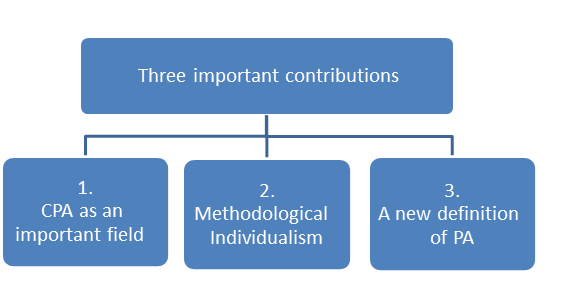Answer:
APPROACH AND STRUCTURE
1. Write an introduction on MBC III.
2. Write some basics about Minnowbrook III.
3. Then write about ethnocentric nature of PA.
4. How MBC III counters it.
5. Comment part: still ethnocentrism prevails.
6. Conclude.
INTRODUCTION: Minnowbrook III was held in2008in two sessions which went on giving greater clarity about PA in term of its future trajectory.
BODY: Minnowbrook III was held on 3‐5 September 2008 and coordinated by Rosemary O‟Leary on the theme of ‘The Future of Public Administration, Public Management and Public Service around the World’. It focussed on how public administration could reassert its role and lead the way in addressing contemporary problems. The focal areas of the conference were:
1. Academic –practitioner relations
2. Democratic performance management
3. Financial management
4. Globalization/comparative perspectives
5. Information technology & management
6. Law, politics and public administration management
7. Leadership
8. Methods/interdisciplinary; networks; performance measurements;
9. Public administration values and theory
10. Social equity & justice
11. Transparency and accountability

What is ethnocentric PA?
Public Administration as a discipline emerged in the western countries so it largely consists of Anglo-American or western premises. PA remains dominated by scholars of these countries.
Minnowbrook I was attended only by the American scholars. They focused only in solving American/western problems. MBCII also focused on western developments and was characterized by ethnocentrism.
But since 1990s onwards developments like globalisation, ICT, post-modern developments have resulted into reversals. Now, developing countries have also started influencing administrative developments. Various journals, associations, studies of these countries’ scholars have led to influence administration.
Therefore, for the first-time developed world is relegating and the new paradigms are emerging. Now, multilateral fora like G7 are being overshadowed by G20 and BRICS. It shows the dominance of developing countries over the developed ones.
MBC III had some global issues and problems including problems faced by developing nations. These issues involved global terrorism, economic crises, sustainable development, digital governance and how to increase 3Es in developing nations. It was attended by 220 scholars and practitioners from thirteen different countries. Minnowbrook conference which started with aim of solving problems of American administration in 1960s but gradually internationalising as US problems like Lehman crisis are becoming global problems due to increased interconnectedness of globe. Rise of global issues like climate change, terrorism which transcend national boundaries. Language barriers reducing due to increased translations.
Based on this experience, the research paper on Minnowbrook-IV conference (2028) talks about shifting From American Minnowbrook to Global Minnowbrook, from isolationism to internationalism. MBC 1 and2 had provided enough recognition to the discipline. MBC III tried to inculcate more diversity and inclusivity in PA.
Therefore, for the first time MBC reduced the ethnocentric nature of PA. it started looking beyond PA in that way can be regarded as more global and less western in perspective.
Comment part:
However still it’s not completely true that PA has done away with ethnocentrism. Still, major researches are done by western countries. The tone of PA is setup by western countries.
CONCLUSION:
Based on this experience, the research paper on Minnowbrook-IV conference (2028) talks about shifting from American Minnowbrook to Global Minnowbrook and dominated by developing nations and their problems.
Spread the Word
